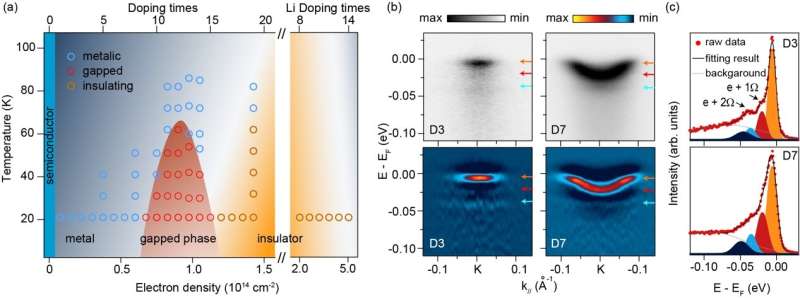An exotic metal-insulator transition in a surface-doped transition metal dichalcogenide

Metal-insulator transition (MIT) driven by many-body interactions is an important phenomenon in condensed matter physics. Exotic phases always emerge around the metal-insulator transition points where quantum fluctuations arise from a competition among spin, charge, orbital, and lattice degrees of freedom. Two-dimensional (2D) materials are a large class of materials. Their simple structure, low dimensionality, and highly tunable carrier density make them an ideal platform for exploring exotic phases. However, the many-body interactions are normally weak in most 2D materials, hence, the correlation-related phenomena attract little attention in the studies of 2D materials for a long period. Recently, people found that the many-body interactions can be enhanced in 2D hetrostructures or artificially-creased 2D structures. Correlation-related phenomena were found in many interesting systems, such as LaAlO3/SrTiO3, twisted bilayer graphene, etc.
Zhang Yan's group in International Center for Quantum Materials (ICQM) at Peking University reports the discovery of an exotic metal-insulator transition in a surface-doped transition metal dichalcogenide 2H-MoTe2 utilizing the high-resolution angle-resolved photoelectron spectroscopy (ARPES) and in-situ surface alkali-metal deposition. They found that the metal-insulator transition could be explained by a location of polarons due to the strong electron-phonon coupling that is enhanced at the sample surface. This work entitled "Metal-Insulator Transition and Emergent Gapped Phase in the Surface-Doped 2-D Semiconductor 2H-MoTe2" was published in Physical Review Letters [Phys. Rev. Lett. 126, 106602 (2021)] on March 12, 2021. Zhang Yan is the corresponding author and Han Tingting, a doctoral student in ICQM is the first author.
The experiments were conducted in a self-constructed ARPES system in Peking University and Beamline BL03U in Shanghai Synchrotron Radiation Facility (SSRF). By using the surface deposition technique, Zhang Yan's group created a 2D metal-semiconductor interface between the surface and bulk layers in 2H-MoTe2. Generally, when carriers are filled into the conduction bands of a semiconductor, the chemical potential raises and the conducting bands shift rigidly towards higher binding energy. However, at the surface of 2H-MoTe2, the researchers found that the conduction bands undergo multiple transitions with the carrier doping across the metallic state, gapped phase, insulator state, and bad-metallic state. Such evolution of electronic structure cannot be explained by the change of chemical potential or surface degradation, suggesting the existence of an exotic metal-insulator transition at the surface of 2H-MoTe2.

Further study found that the surface of 2H-MoTe2 exhibits a complicated phase diagram, which resembles the phase diagrams of a quantum phase transition driven by many-body interactions. Meanwhile, the detailed spectrum analysis resolves the existence of replica bands which is normally viewed as a fingerprint of strong electron-phonon coupling. Combined with the observed energy renormalization of spectra and the evolution of band dispersion, the researchers conclude that the electron-phonon coupling is strongly enhanced on the surface of 2H-MoTe2. Electrons are dressed by lattice excitations, forming polarons. The polarons then localize due to impurity or disorder scattering, which drives the observed metal-insulator transition.
This work demonstrates how a complicated metal-insulator transition could occur on the surface of a simple two-dimensional semiconductor. On the one hand, the results highlight the surface-doped 2H-MoTe2 as a strong candidate material for realizing polaronic insulator, polaronic extended state, and high-Tc superconductivity. On the other hand, the experiments show that the surface alkali-metal deposition can enhance the many-body interactions in two-dimensional semiconductors, which opens a new way for exploring the correlation-related phenomena in two-dimensional materials. This work was supported by the National Natural Science Foundation of China, the National Key Research and Development Program of China.
More information: T. T. Han et al, Metal-Insulator Transition and Emergent Gapped Phase in the Surface-Doped 2D Semiconductor 2H−MoTe2, Physical Review Letters (2021). DOI: 10.1103/PhysRevLett.126.106602
Journal information: Physical Review Letters
Provided by Peking University





















